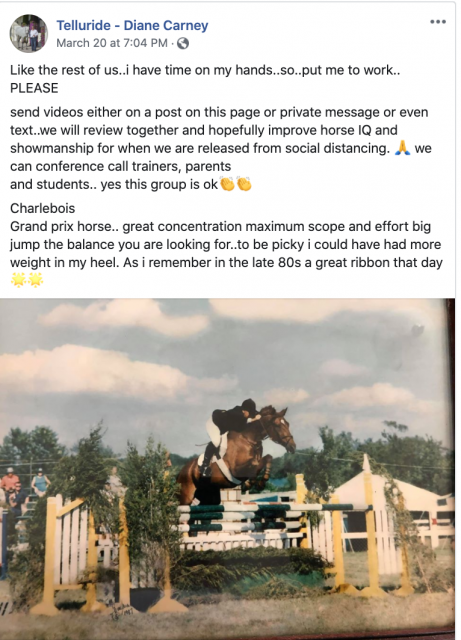Now many of us know what stall rest feels like, right? Shelter-in-place orders and forced closures of equestrian facilities nationwide mean significantly less barn time for some.
While there is no substitute for spending time with your horse, the team at Strider (formerly Event Clinics) has some creative ways for you to feel connected to your equestrian community and keep making progress on your goals while you’re confined to your home.
#LearnFromTheBest
Check out training insights and helpful exercises from one of your favorite clinicians.
We recommend: The Rutledge Farm Sessions Clinic Series, available to stream for FREE on USEF Network with code ‘Rutledge19’.
The esteemed list of clinicians includes Peter Wylde, Boyd Martin, Will Simpson, Phillip Dutton, Allison Brock, Debbie McDonald, and Stacia Madden.
Also Notable: The United States Eventing Association has a great library of educational videos which can be accessed here. Check out Andrea Waldo’s ‘Train Your Brain for a Confident Ride’ talk from the 2019 Annual Meeting & Convention in which she breaks down mental skills to help you ride with confidence & focus.
Stay Connected
Many judges and top riders are going digital to stay engaged with the equestrian community. Check out the possibility of submitting a short riding video to a judge for some feedback- it’s likely to be very positive and constructive!
Alternatively, some top riders are taking suggestions for learning center-style videos via social media. Plus, we’ve seen a rise in webinars and digital meetups where you can participate and ask your own questions.
We recommend: International Dressage rider Lauren Sprieser’s ‘Virtual Cocktail Party’ Series featuring vets, mental skills coaches, grand prix competitors, and other interesting guests. These are free, but you must RSVP to receive the Zoom link. More details here.
Also notable: Revered hunter/ jumper & equitation judge, clinician, and coach Diane Carney is offering up some virtual coaching.
Or, if you have a recent video of a dressage test you can enter a virtual horse show like this one being hosted by Mitchell Dressage Series.
Review Past Rides & Plan Ahead
Take some time to scroll through your old lesson, clinic, or show videos. It can be very helpful to note changes in your position and as improvements in your horse over time. Write down things you’ve gotten better at, and where there’s still some work to do. First and foremost though, be kind to yourself- nobody’s perfect.
This reflection and additional visual insight can help you make a plan for when you do get back in the tack. The implications of COVID-19 have surely derailed your riding plans, so now it’s time to adjust the goals you may have set for yourself at the beginning of 2020.
Remember in goal setting it’s important to set SMART goals. Those are goals that are specific, measurable, achievable, realistic, and timely.
We recommend: Dropping that ‘T’ from your SMART goal-setting, for now. Let’s not get too caught up in the calendar.
Stick Your Nose in a Good Book
There’s no time like the present to dive into your reading list.
Looking to get inspired by some equestrian literature? Horse and Rider Books is having a spring sale, so find what piques your interest and enjoy 20% off your order.
We recommend: Tik Maynard’s In the Middle are the Horsemen, a memoir which chronicles much of what the author learned about himself, horsemanship, and the process by which horses and humans can learn from one another throughout his time as a working student for some of the most renowned names in the horse world.
Keep Moving
There are many resources for at-home workouts that are offering complimentary access during the COVID-19 crisis. Even if it’s just a few minutes a day, keeping your body moving will help you combat any feelings of ennui while you are staying home to keep yourself and your loved ones safe. Plus, you’ll keep working those core muscles and your horse will thank you later.
We recommend: Alo Moves has a great catalogue of yoga, pilates, and barre classes that you can easily do from home. They’ve got a 2-week free trial AND, better yet, a library of Community (ahem, free) Classes on YouTube.
Also Notable: This fun set of exercises from InForm Fitness’s Laura Crump Anderson designed to make you stronger in the saddle.
Give Thanks
Check in on barn managers, working students, and trainers who are toughing it out providing the best care to your four-legged friends. Remember that they’re worried about their families too, and they’ll send you a cute photo video of your horse when they have a minute to do so.
Thank these wonderful teams for the impeccable care that they provide your horses every day, but especially now during these very trying times.
Together, but from a distance, we’ll get through this. Stay safe!
#StrideForward





























